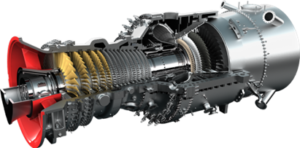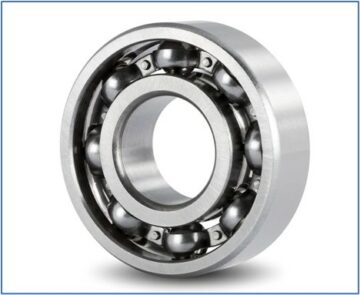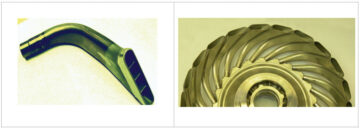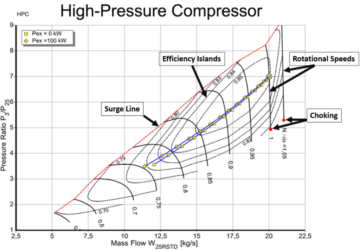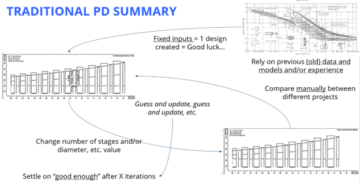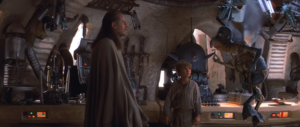Centrifugal Compressors are the turbomachines also known as turbo-compressors, and belong to the roto-dynamic class of compressors. In these compressors the required pressure rise takes place due to the continuous conversion of angular momentum imparted to the working fluid by a high-speed impeller into pressure. These compressors are used in small gas-turbines, turbochargers, chiller units, in the process and paper industries, oil & gas industries and others.
The design and manufacturing of such compressors are always challenging because of its 3-dimensional shapes, high rotational speeds that interact with different loss mechanisms, and stringent working environments. In many circumstances, it is necessary to analyze an existing compressor, with the end goal being to redesign it, enhance its performance, or to use it in completely different applications. In order to meet such requirements, reverse engineering is a viable option. With reverse engineering, one can review competitor’s design to remain in market competition.
Reverse Engineering
Reverse engineering allows us to collect incomplete or non-existing design data and manufacture an accurate recreation, safely, of the original product or component.
Sometimes, it is also referred to as back engineering, in which centrifugal compressors or any other product are deconstructed to extract design information from them. Oftentimes, reverse engineering involves deconstructing individual components like the impeller or diffuser of larger compressors. End-users often use this approach when purchasing a replacement impeller or any other compressor part from an OEM is not an option. In some cases, where older impellers that have not been manufactured for 20 years or more, the original 2D drawings are no longer available. When this is the case, the only way to obtain the design of an original compressor is through reverse engineering.
Reverse engineering requires a series of steps to gather precise information on a product’s dimensions. Once collected, the data can be stored in digital archives. Figure 1 (left) shows the typical process of reverse engineering. In figure 1 (right), one can see the scanning process of the centrifugal impeller using a laser scanner.

To reverse engineer an impeller or any other part of compressor, an organization will typically acquire the component and take it apart to examine its internal mechanisms. This way, engineers can unveil information about the original design and construction of the product. One can start by analyzing the dimensions and attributes of the impeller and make measurements of the blade widths, diameters and angles, as these dimensions often relate to the compressor’s performance.
In the current scenario, 3D scanning technologies are usually preferred to extract the information of existing models. With three-dimensional scanners, engineers can acquire accurate readings of the compressor specifications and have this information automatically logged in their databases. After all the pertinent information has been gathered and recorded, engineers can use this data to create CAD drawings for subsequent analysis and development. These digital models help to unveil design intent and inform the creation of a reverse-engineered component. After the CAD model generation, manufacturing is the final step in which the object can be re-created to replace an original impeller to provide like-new performance.
Is Reverse Engineering really an Easy Task?
As mentioned above, the reverse-engineering process has several steps, with the most challenging task being to convert the scanned data of an impeller or any other component into useful form. Generally, this is done by utilizing CAD programs which process scanned cloud points into 3D surface models, but this is a very time and resource consuming task. To accomplish this process quickly presents a serious challenge. A designer can, however, save time, if a program like that found in the AxSTREAM platform is used to extract the impeller’s geometrical and cascade information to create full 3D model as shown in figure 2. After creating the full model, the designer can perform 1D/2D/3D analysis of the existing turbomachine, and redesign it to enhance the performance or for completely different applications.

While the concept of a digital twin has been around since 2002, it is only thanks to the Internet of Things (IoT) that it has become cost-effective to implement. Quite simply, a digital twin is a virtual model of a process, product like a compressor and its operation. This pairing of the virtual and physical worlds allows data analysis and system monitoring to head off problems before they even occur. Digital twins can also be used to prevent downtime, develop new opportunities and even plan for the future through simulation. The digital twin enables engineers to monitor a turbomachine’s performance over time, thanks to the advances in digital technology.

Designers can make more informed choices for future designs and ensure simulations are accurate and reflective of the real world. More importantly, digital twins make predictive maintenance possible. Instead of redundant servicing and maintenance in the mission of avoiding downtime, designers can visualize exactly when and where maintenance is needed, instead of making blind guesses and needless budget expenditures. Once any turbomachine has been reverse engineered, a digital twin of it can be created in a program such as AxSTREAM, and engineers can pinpoint what kind of maintenance and servicing needs to happen, and when it needs to be done.
Conclusion
Reverse engineering is a viable option to develop new compressor designs based on older design strategies, to upgrade existing machines, ensure easy maintenance and much more. Reverse engineering along with creating a digital twin can enhance design quality, reduce product development time, and lower compressor maintenance cost.
Here, AxSTREAM can be a great choice for designers to reverse engineer turbomachinery and create digital twins in a very short timespan, generating valuable data that can be used to show the path forward for design upgrades, and assure engineers that their machines will continue to run well into the future.
For more information on how AxSTREAM and its digital twin capabilities can benefit you and your team, request a software trial!
- 3d
- analysis
- applications
- around
- Automation
- BLADE
- CAD
- cases
- challenge
- Cloud
- competition
- component
- construction
- continue
- Conversion
- Creating
- Current
- data
- data analysis
- databases
- Design
- Designer
- develop
- Development
- digital
- digital twin
- Digital twins
- downtime
- engineer
- Engineering
- Engineers
- Figure
- form
- Forward
- full
- future
- GAS
- great
- head
- High
- How
- HTTPS
- industries
- information
- intent
- Internet
- internet of things
- iot
- IT
- laser
- Machines
- Making
- manufactured
- manufacturing
- Market
- Mission
- model
- Momentum
- monitoring
- Oil
- Option
- order
- Other
- Others
- Paper
- performance
- platform
- pressure
- Product
- product development
- Program
- Programs
- quality
- redesign
- reduce
- Requirements
- resource
- reverse
- review
- Run
- scanning
- Series
- Short
- simulation
- small
- Software
- start
- Surface
- system
- Technologies
- Technology
- The Future
- time
- turbine
- us
- Virtual
- world
- years

